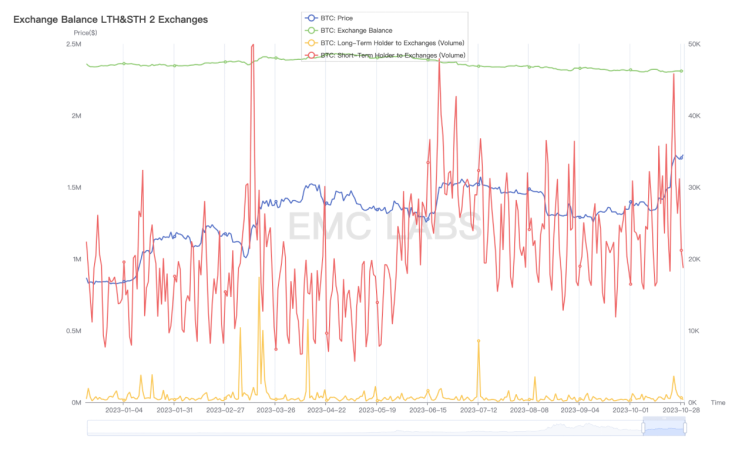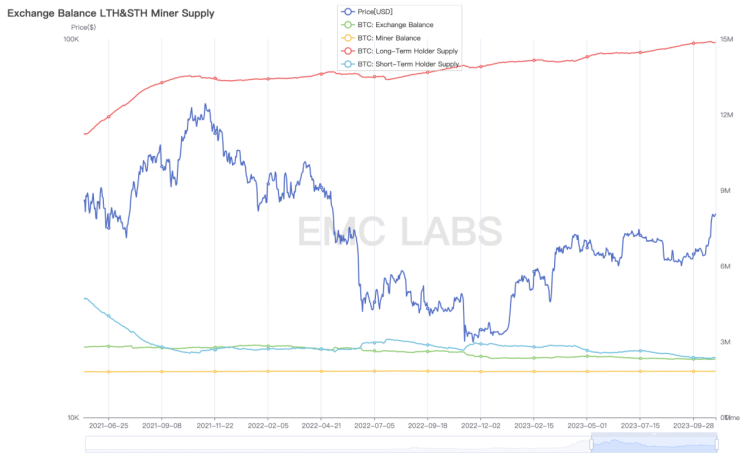EMC Labs October Briefing: As scheduled breakthrough, BTC is likely to oscillate upward along the upward channel in the future market
Author: EMS Labs
Macro Market
In the golden autumn of October, those who deeply understand the cyclical nature of markets and hold steadfastly are joyfully welcoming a bountiful harvest!
After a long period of ambiguity and volatility, driven by expectations of spot ETFs, BTC has broken out of a six-month-long consolidation box, returning to an upward channel with a monthly increase of 28.54%, continuing its recovery journey.
In the September Brief, EMC Labs predicted that the bullish sentiment in Q4 would drive BTC to break through the previous high of $32,000. Now, this prophecy has already been fulfilled in the first month. The market's momentum is unexpectedly fierce.
However, the global macro financial market is not optimistic. After experiencing the largest monthly decline of the year in September, the NASDAQ fell another 3.25% in October. With no interest rate hikes seen in November and uncertainty about December, coupled with pressure from discussions of a U.S. economic recession, the NASDAQ has declined for three consecutive months after the AI hype subsided, marking the end of this year's rebound. The macro financial market is filled with a heavy atmosphere of caution. 
NASDAQ Monthly Trend
With an unclear outlook, market funds have chosen to enter "gold" as a safe haven, pushing gold prices up by 8%, nearing historical highs.

Gold Price Daily Trend
In contrast, the cryptocurrency market, which had stopped falling and slightly increased in September, broke out in October, significantly rising and breaking through the upper edge of the consolidation box at $32,000 that had troubled the market for half a year, pushing prices to around $35,000.
According to the Emergence Engine signals, the recovery period of this cycle began in January and has progressed for 10 months so far, with a total of 7 months recording increases. Among these 7 months, October's increase is second only to the dramatic rebound in January, making it the second-largest increase month of the year. The significant increase in volume indicates that the bulls are determined to break through the box's resistance with passion.

BTC Monthly Trend
Behind the surge, a monthly inflow of $900 million in stablecoins is the direct cause. Although $900 million is not a large amount, it is the only month this year that has seen a positive inflow. This may indicate a change in the attitude of off-exchange funds.
BTC's market performance this month fully confirms EMC Labs' judgment that "with strong on-chain data support, the market will rise rapidly once funds flow back in."
This month, the trend of BTC's recovery period "shifting from short to long" continues, but there are signs of slowing down as prices rise. The short-term surge has triggered a wave of selling from both short and long holders, but the selling has now subsided. However, the scale of profits remains substantial, becoming a driving factor for current price fluctuations.
On-chain data deteriorated in October but recovered after the surge, suggesting that caution should be maintained in the future.
Considering multiple factors, EMC Labs believes: the trend of the recovery period continues, October has confirmed our previous judgment, and in November and December, the market will oscillate upward along the rising channel amidst bullish and bearish divergences.
Cryptocurrency Market
In October, BTC opened at $26,961 and closed at $34,656, with an increase of 28.54% and a volatility of 32.03%.

BTC Daily Trend
From a technical perspective, October was also a month of abundant gains.
Since mid-March this year, BTC has entered a box structure (the purple area in the above chart), with the lower edge at $25,000 and the upper edge at $32,000. On October 23, it broke through the upper edge after consolidating for more than 180 days. During this period, there were two unsuccessful attempts to break the upper edge in April and July, while June, August, and September continuously tested the lower edge support. Notably, the price fell below the rising channel since the beginning of the year in August and September (the blue area in the above chart).
Most of the selling pressure during this period came from short whales.
In the September brief, we pointed out that the downward test in August and September had ample time. At the end of September, the market began to attempt an upward movement and conducted another support test in the first half of October, ultimately entering a violent upward mode on the 15th, pushing the price from $26,000 to $35,000 within 11 trading days.
On key breakout days such as the 16th, 23rd, and 24th, there was significant volume, indicating that bullish funds were bold and refused to pull back after eating through the shorts, instead waiting for the moving averages to rise, suggesting that the market will continue to push higher after adjustments.
Funding Supply
This year, we have observed a continuous improvement in on-chain data, akin to a stack of firewood becoming drier. However, the explosive upward movement relies not only on the dehydration of the firewood (internal factors) but also on the flame that ignites it (external factors).
Now, we focus on the supply of stablecoins to examine external factors.

Major Stablecoin Supply
In previous reports, we pointed out that the buying power for BTC's rise during the recovery period mainly came from the replenishment of positions by on-exchange funds. In fact, behind BTC's 100% surge this year, overall funds have been in a state of outflow, with a total outflow of $14.6 billion from the beginning of the year to the end of September.
In the September report, we noted that the outflow of stablecoins was slowing down.
In the first half of October, the outflow of stablecoins showed signs of stagnation, and by the 15th, stablecoins began to show positive inflows, leading BTC to initiate its upward trend.
By the 30th, the net inflow of stablecoins in October had reached $900 million!
This marks the first monthly positive inflow of stablecoins this year, indicating that the exit of on-exchange funds has been curtailed and off-exchange funds are starting to enter.
This is the most optimistic external factor monitored by EMC Labs since on-chain data emerged from the bear market—stablecoins are beginning to exit the bear market.
The net inflow of stablecoins and the initiation of BTC's price movement occurred on the same day, confirming that the most direct driving force behind the explosive rise comes from off-exchange funds entering through stablecoins.
Furthermore, we focus on the largest supply scales of USDT and USDC.
1.1~10.30------
USDT: +$18.28 billion;
USDC: -$19.25 billion.
9.30~10.30------
USDT: +$1.4 billion;
USDC: -$0.1 billion.
It is evident that USDT has seen net inflows throughout the year, while USDC has experienced significant outflows, which began to stabilize in October. The Asian funds (as well as those from Europe and South America) primarily using USDT have dominated BTC's rebound this year. The significant breakthrough this month is more evidently driven by the $1.4 billion increase in USDT issuance.
For future market assessments, observing stablecoins is indispensable.
Entering the first month of Q4, we have witnessed the first month of net inflow of funds this year. If the months of November and December continue to see net inflows, a market phase referred to as a "bull market" will likely approach us.
Supply Trends
Accompanying BTC's violent rise in the latter half of the month, the profitability of on-chain BTC has significantly improved. The overall market MVRV (Market Value to Realized Value) reached 68%, with long-term holders (LTH) at 66% and short-term holders (STH) at 20%.

Market Supply Pressure
In the short term, the rapid and significant increase has sharply raised market supply pressure, especially for short holders, as the 20% profit threshold has been reached. The inevitable selling after satisfaction may explain why BTC is consolidating around $34,000 to $35,000.
We further examine the profit/loss situation when long and short holders sell BTC.

BTC Selling Profit and Loss Situation
As BTC prices rise, the selling profits of both long and short holders have significantly increased, with some long holders achieving profits as high as 61-70%, while short holders' profits have also approached 6%.
In addition to selling profits, we further examine the selling scale of long and short holders.

Exchange Balance LTH & STH 2 Exchanges
The 24th was a day of new highs in the rebound and also a peak for selling by long and short holders. On this day, long holders sold 3,724 BTC, while short holders sold 45,874 BTC, both several times the usual selling scale.
The 24th was the third-largest selling day for long holders this year and the eighth-largest for short holders.
This wave of profit-taking selling has now subsided, and the scale entering exchanges has dropped to around 20,000 BTC per day.
From the perspective of exchanges, as of the 29th, CEX holdings have decreased by 5,000 BTC this month, without piling up greater selling pressure. However, compared to the outflow scale of 60,000 BTC in September, this month's outflow has significantly decreased.
Moreover, the potential profit for short holders remains as high as 20%, necessitating new short holders to enter and lower the profit margin. As the market improves, the potential profit for short holders during the recovery period could rise to 40%, leaving considerable room compared to the current 20%.
However, short trading is driven by sentiment, which is primarily influenced by external factors. If large-scale selling occurs, it may trigger price fluctuations, requiring continuous attention.
Long-Short Game
Currently, both long and short holders still hold substantial profits, with the overall profit scale of BTC approaching 15.98 million BTC, accounting for 81.82% of the total supply. In this situation, selling pressure continues to increase, and we need to further examine the holding scale of long and short holders to assess the real selling pressure.

Long Holders, Short Holders, Central Exchanges, and Miners BTC Holding Scale
10.1~10.30------
Long Holders: +34,000
Short Holders: -1,000
CEX: -5,000
Miners: +3,000
Long holders and miners continue to accumulate, while short holders and CEX continue to see outflows. Although the price has achieved a monthly increase of 28.54%, the trend of "shifting from short to long" continues, which is a typical characteristic of the recovery period.
The scale held by short holders continues to decrease, while the selling pressure from long holders will only appear at higher MVRV values. Although the rate of loss is declining, market liquidity is still decreasing, while purchasing power is recovering. Overall, mid-term liquidity remains assured.
In previous monthly reports, we continuously tracked the short whale group. During the past six months of adjustment, they once dominated the market's volatility.
In October, this group continued to reduce holdings to realize profits. Currently, the 310,000 BTC they accumulated at the bottom has been nearly sold out, and they are still selling their inventory, with a net sale of 110,000 BTC in October.
Against the backdrop of net inflows of funds, their selling behavior can no longer impact the market. However, they still hold over 6 million BTC, which remains a significant selling force, especially during weak market conditions, likely to have a noticeable impact on mid- to short-term trends.
On-Chain Data
From late September to mid-October, the unclear outlook and market downturn caused a severe decline in new address data. After the rebound, driven by speculation, new on-chain addresses have rapidly increased.

BTC Daily New Addresses
Similar changes have also been observed in active entities and daily transaction data.

Bitcoin Network Daily Active Entities

Bitcoin Network Daily Transaction Volume
It is important to note that with the rise of Ordinals, the data structure of the Bitcoin network has changed, and the recent decline in on-chain activity is also related to the waning speculative frenzy surrounding Ordinals-based NFTs and BRC-20 meme coins.
Excluding these factors, on-chain activity is an important influence on price, warranting long-term and in-depth tracking. The mid- to long-term price trend cannot diverge from on-chain activity.
Conclusion
In the September Brief, EMC Labs judged: "The bullish forces in Q4 are likely to actively take action, pushing the market to challenge the annual high of $32,000 again, and it is highly probable that BTC will historically break through the upper edge of the box that has confined it for half a year, ending a recovery period that, although bumpy, has been hard-earned."
As October comes to an end, the predictions have already been fulfilled by the market.
Regarding future market trends, considering on-chain supply, on-chain activity, and technical indicators, EMC Labs believes: after the explosive rise, the loosened chips among long and short holders have realized profits, and the trend of "shifting from short to long" continues. The trend of the recovery period persists, and in November and December, the market will oscillate upward along the rising channel amidst bullish and bearish divergences.
A return to the box, specifically below $32,000, is an extremely low-probability event. If it occurs, it will present an excellent opportunity for re-entry.
Key internal factors to watch include the recovery of on-chain data, BTC-ALTCOIN rotation, and the selling of short whales, while external factors include net inflows of funds, NASDAQ trends, and the possibility of economic recession. Conversely, the impact of U.S. interest rate hikes may be the weakest; if another rate hike occurs in December, the market will likely view it as the final shoe dropping.
++EMC Labs was established in April 2023 by cryptocurrency asset investors and data mining engineers. It focuses on blockchain industry research and secondary market investments in crypto, with industry foresight, insights, and data mining as core competencies, aiming to participate in the thriving blockchain industry through research and investment, promoting the benefits of blockchain and crypto assets for humanity.++
++For more information, please visit: https://www.emc.fund++









